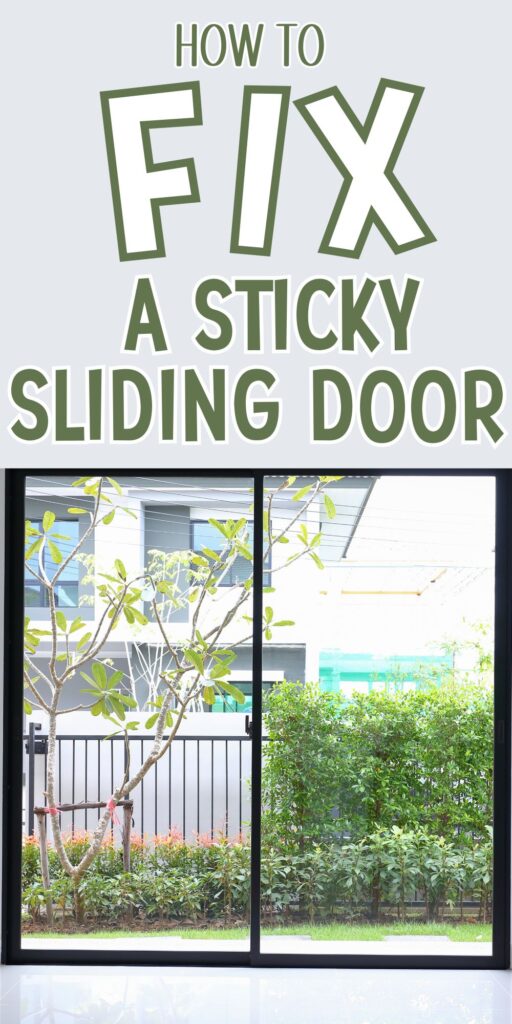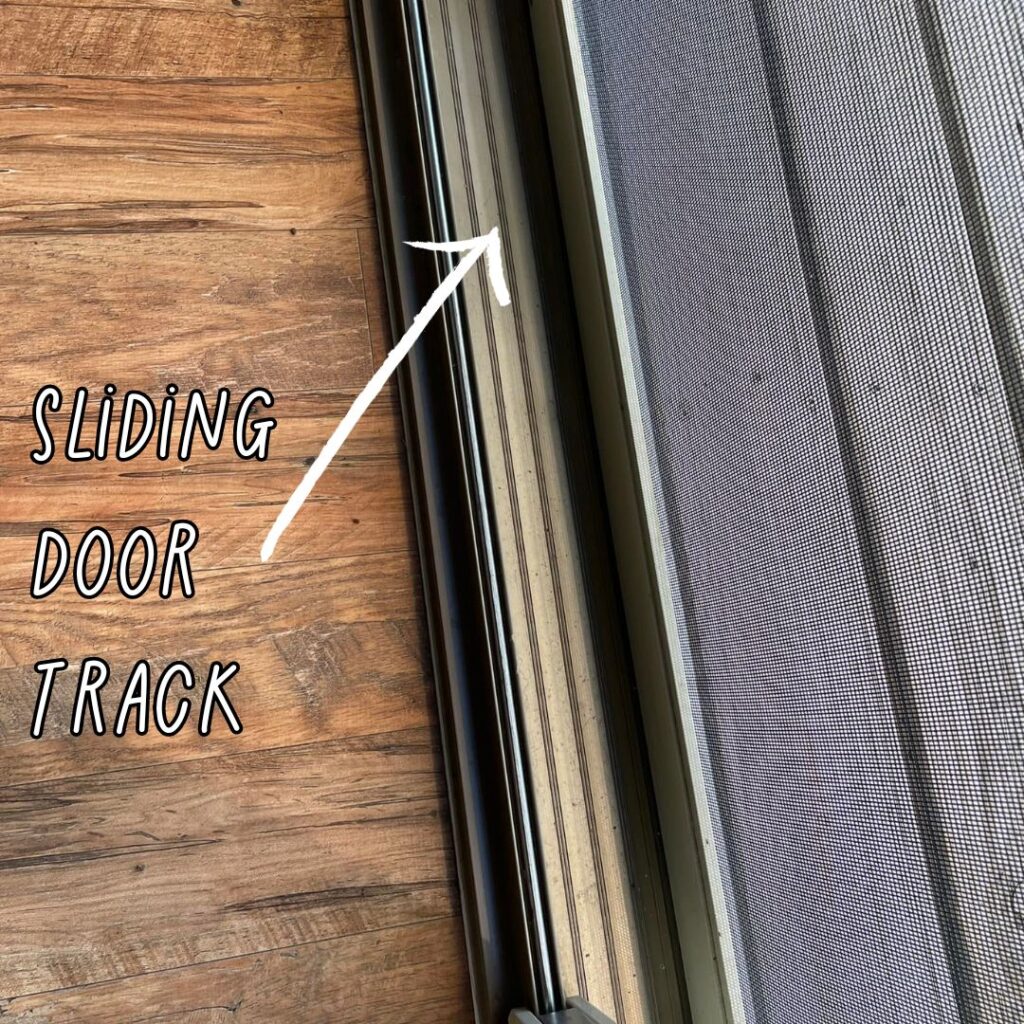Sticky Sliding Doors: Quick Fixes to Get the Glide Back
There’s nothing quite as frustrating as sticky sliding glass doors! Just when the dog is going crazy to get outside, you try to open the sliding glass patio door and it gets stuck. You struggle, the dog is losing his mind, and you finally get it open a crack so Rufus can squeeze out.
Then you can’t get it closed again. Ugh!
This exact scenario sent me into the world of sticking sliding doors where I learned (and executed) some tips and tricks that can fix a sliding door. I’ve lived in old houses for over 2 decades, and it has happened more than I like to admit.
I learned there are a few reasons for sticking sliding glass doors; it could be due to dirt accumulation, misaligned tracks, damaged rollers, or even a result of humidity and temperature changes. I learned a few DIY fixes and when to call in a pro.
As an Amazon Associate I earn from qualifying purchases. This means if you click on a link and buy something I’ve recommended, I get a small commission at no additional cost to you. You can see my full Disclosure Policy here.

How do Sliding Doors Work?
The first step to learn how to fix a sliding door is knowing how they work. Sliding doors operate on a horizontal track system that allows them to move horizontally instead of swinging open or closed. They typically consist of:
- Door Panels: The actual doors that slide horizontally. They can be made of various materials like glass, wood, metal, a combination, or even screening in a frame.
- Tracks: Rails mounted horizontally at the top and bottom of the door frame. The tracks guide the door panels, enabling their smooth sliding motion.
- Rollers or Wheels: Attached to the bottom of the door panels, these components roll along the tracks, allowing the doors to slide seamlessly back and forth. Larger sliding doors may have rollers on both the top and bottom of the jamb.
- Handles or Latches: Used to open and close the doors.
- Frame: The structure surrounding the doors that holds everything together. It provides stability and support for the tracks and door panels.
When you push or pull the door back and forth, the rollers move within the tracks, allowing the door to slide open or closed. It’s a simple but effective mechanism that’s pretty easy to troubleshoot.
This is how most sliding doors are designed. Whether it’s a sliding glass door, a sliding closet door, a sliding shower door, or a sliding screen door, these tips to fix a sticky sliding door should help you with your door sliding issues.
What Causes Sliding Patio Doors to Stick?
Dirt and Debris Buildup
Dirty tracks are the most common reason a sliding door sticks. Because I have a dog that sheds a lot, dirt and debris gather quickly in the tracks. This can cause friction and make the door difficult to slide. To fix this issue, cleaning the track and rollers usually does the trick.
Lack of Lubrication
Without proper lubrication, the metal tracks and rollers in direct contact can experience increased friction leading to resistance when opening or closing. Over time, this friction can wear down the components and cause them to become difficult to move smoothly along the track. Regular lubrication helps minimize this friction and prevents potential damage to the door mechanisms.
Worn Rollers or Wheels
The rollers or wheels on the bottom of the door panel that help the door slide can wear out over time. This can lead to difficulties in movement or even cause the door to come off the track. Replacement rollers may be needed to fix a sliding glass door that sticks.
Misalignment
If the door panels or the tracks become misaligned, the increased friction can make it hard to slide the door smoothly. It can also cause the doors to squeak or not seal correctly. Realigning the rollers or wheels attached to the door and adjusting them to sit properly within the tracks can fix alignment issues. Structural issues in the door frame or the tracks can also affect functionality.
Weather Exposure
Weather exposure in harsh climates can impact sliding doors through expansion or contraction and lead to warping or misalignment. Continuous exposure to moisture can result in rust or corrosion of metal components and prevent smooth movement. Condensation in cold weather can also cause the rollers or the track to freeze.
Impact Damage
Accidental impacts or excessive force applied to the doors can cause dents, cracks, or damage to the frame, tracks, or door panels. These are more serious issues that are more complicated to repair. When this happens, it may be time to call in a professional if you are not confident with your DIY skills. This post does not get into repairing sliding doors that have been damaged by impact.
How to Remove Sliding Glass Doors
- Grab the sides of the door and lift the door so that the top of the door moves into the top track. Get some help if the doors are very heavy.
- Pull the bottom of the door towards you to get the bottom of the door off the bottom track. Insert a screwdriver between the door and the track if necessary to get the door to move.
- Once the door is removed, carefully move the door out of the way and put it in a safe place.

Clean Sliding Door Tracks and Rollers
As dirty tracks or rollers are one of the main reasons a sliding door is sticking, the first step to keep a sliding door from sticking is to clean the door tracks and rollers. Here’s a simple process to follow:
Remove the door from its track
Lift the sides of door and pull the door out from the bottom to remove it. Place it in a secure location out of the way, ensuring you can access the rollers easily.
Use a vacuum cleaner with a brush attachment to vacuum the track
Vacuum up any loose dirt in the tracks. Don’t forget to vacuum around the rollers on the bottom of the door to remove any loose dirt.
Wash the track and rollers
Using hot, soapy water and a cloth, clean all remaining dirt from the track and wheels. For stubborn dirt, use a toothbrush or wire brush to scrub. Dry the track and wheels with paper towels.
Degrease the track and rollers
Once the track is clean, pour some rubbing alcohol into the track and let it sit for a minute or two. Then wipe it up with a clean cloth to remove any remaining greasy buildup and grime. Then wipe the rollers with the same cloth dampened with rubbing alcohol to remove any sticky debris on the rollers. The rubbing alcohol will evaporate quickly, so there’s no need to dry it.
The next step is to lubricate the track and wheels to minimize friction and resistance that can cause the door to stick.
Lubricate the Track and Hardware
Lubricants help your sliding door glide smoothly. It’s a good idea toavoid using oil-based lubricants as they can attract dust and dirt. Here’s a short list of what I have found to be the most effective options:
- Silicone spray: Silicone lubricant is my go-to lubricant for sliding doors because it dries quickly and doesn’t attract dust.
- Graphite powder: A dry lubricant that works well for sliding door locks and isn’t messy.
- White lithium grease: A heavy-duty option that provides long-lasting lubrication and is ideal for metal door tracks.
Lubricating the tracks and rollers reduces friction, preventing sticking and ensuring ease of movement. Here’s how to do it:
Apply a thin layer of lubricant to the track
Use the applicator nozzle or a small brush to spread a thin, even layer along the track’s length, focusing on the areas where the door makes contact with the track.
Lubricate the rollers
Apply a small amount of lubricant directly onto the rollers. Rotate the rollers to help spread the lubricant evenly.
Reinstall the door
Lift the sliding door high enough to clear the bottom of the door track. Tilt the bottom of the door toward you while placing the top of the door into the track to help align the wheels or rollers with the track. Position the bottom of the door back onto the lower track by guiding the wheels or rollers into the track’s groove and letting it drop gently to fit securely into the track.
Test the movement of the sliding door
After you replace the door, slide the door back and forth along the tracks to evenly distribute the lubricant and to confirm it moves smoothly without sticking.
Remove excess lubricant
Use a paper towel to wipe away any excess lubricant and prevent buildup.
Adjust Sliding Door Rollers
Sometimes cleaning and lubricating the tracks and rollers isn’t enough to fix a sticking sliding glass door and you may have to adjust the rollers on your door panel. This is a general guide to adjusting rollers. Consult your door’s manual or manufacturer’s instructions for specific information for adjusting the rollers, as different door designs may have different methods.
Find the adjustment screws
Most sliding doors have adjustment screws at the bottom or sides of the door. These screws control the height and sometimes the tilt of the door.
Access the rollers
Lift the sliding door slightly to relieve pressure on the rollers, making it easier to adjust. If needed, use a door stopper to hold it in place.
Find the screws
Some doors have access holes or covers that need to be removed to reach the adjustment screws. Others might have exposed screws visible on the bottom or sides of the door.
Adjust the rollers
Use a screwdriver or the specific tool provided by the door manufacturer to turn the adjustment screws. Clockwise turns usually raise the door, while counterclockwise turns lower it. Make small adjustments to avoid misaligning the door.
Test the door
Slide the door along the track to check the adjustments. Ensure the door moves smoothly without sticking or dragging. Make further adjustments if necessary until the door operates smoothly.
Tighten the screws
Once you’ve adjusted the rollers and the door moves smoothly, tighten any locking mechanisms or screws to secure the position of the rollers.
If these adjustments seem too challenging for you or nothing you do is working, you may need to get professional assistance
Replace Sliding Door Rollers
Sometimes the rollers can get worn, bent or misshapen due to excessive use and need to be replaced, especially if the door is older. Here’s a general outline of the steps to take to replace the wheels or rollers if you are a confident DIYer.
Replacing rollers might vary depending on the door’s design, so consulting the door’s manual or seeking guidance specific to your door model could be beneficial. If the process seems complex or challenging to you, seeking professional assistance can ensure the job is done correctly.
Remove the door
Lift the sliding door upwards to clear the bottom track, then angle and remove it from the frame. Lay it on a flat, stable surface.
Find and inspect rollers
Typically, you’ll find the rollers at the bottom of the door. Some might be held in place by screws or brackets that need to be removed. Check your door’s manual or manufacturer’s instructions to find them if they aren’t obvious. Once you have found them, check the rollers for damage.
Remove old rollers
Detach the rollers from their housing or brackets. You might have to unscrew them or release them from their mounting mechanism.
Install new rollers
Align the new rollers with the housing or brackets and secure them in place using the provided screws or locking mechanisms. Ensure they are installed correctly and securely.
Reinstall the door
Lift the door and carefully place the new rollers into the bottom track. Tilt the top of the door back into the upper track and lower it gently, ensuring the rollers fit properly into the track.
Test the door
Slide the door back and forth along the track to confirm that the new rollers function correctly and the door moves smoothly without sticking or dragging.
Make adjustments if necessary
If the door doesn’t glide smoothly, adjust the new rollers using the instructions outlined above until the door operates smoothly.

What To Do If You Have a Frozen Sliding Door
If your outside sliding door freezes shut due to cold weather, here are some steps you can take:
Remove excess ice
Carefully chip away excess ice with a plastic spatula or another tool to ease the door’s movement once it starts thawing.
Thaw with gentle heat
Use a hairdryer or a heat gun on a low setting to gently warm the edges and tracks of the door. A heat lamp or even a hot water bottle placed near the door can also help raise the temperature and melt the ice. Avoid using excessive heat to prevent damage.
Apply de-icing solution
Use a commercial de-icer or rubbing alcohol to melt the ice around the edges. Spray or apply it carefully to avoid damage.
Freeze-proof
Apply a silicone-based lubricant or a non-stick solution to the tracks and edges of the door to prevent future freezing. This can help reduce ice buildup because some silicone-based or dry lubricants have properties that resist freezing at lower temperatures.
Replace weatherstripping
Over time, weatherstripping can deteriorate due to regular use, exposure to weather elements, or physical damage. Excessive moisture, freezing temperatures, or intense sunlight, can cause weatherstripping materials to expand, contract, crack, or lose their shape, and allow the weather to enter the door.
Prevent condensation
Condensation occurs when warm, moist air comes into contact with cooler surfaces, like a cold sliding glass door. If condensation is causing your sliding glass door to freeze, running a fan facing the door can prevent condensation by promoting air circulation and maintaining a consistent temperature. It also helps moisture evaporate more quickly, reducing the chances of forming condensation.
Remember to avoid using excessive force or tools that could damage the door or its frame. Patience and gentle methods are key to safely thawing a frozen sliding door.
Related Post: Home hacks to make a cold house warm (and save on heating bills!)
How to Prevent Sticky Sliding Doors
As someone who has dealt with sticky sliding doors more than I care to admit, I know how important it is to prevent issues before they become worse. Regular maintenance is the best way to avoid a sliding door that sticks.
Regular Cleaning and Lubrication
Keeping the sliding door tracks clean and well-lubricated is essential in preventing sticky doors. Here’s my routine for regular maintenance:
- Clean the tracks: Use a vacuum or brush to remove any dirt, debris, and pet hair from the tracks. Then, use a cloth or sponge with a mild cleaning solution to get rid of any stubborn dirt or grime. I also wipe down the tracks and rollers with rubbing alcohol to remove any gummy deposits that have formed.
- Lubricate the tracks: After cleaning the tracks, apply a thin layer of silicone-based lubricant.
Note: I try to perform this routine at least once every three months.
Timely Repairs and Adjustments
Another crucial aspect of maintaining sliding doors is addressing any issues as soon as they arise. Here are some common problems and my go-to solutions:
- Loose or damaged rollers: If I notice my door isn’t gliding smoothly, I’ll inspect the rollers for damage or looseness. I might need to tighten the screws, replace worn-out rollers, or adjust the door’s height.
- Misaligned door: If my sliding door appears to be off the track or not closing properly, I’ll check the alignment. I can usually fix this problem by adjusting the screws at the bottom of the door, bringing it back into its proper position.
- Damaged weatherstripping: I check the weatherstripping on the door every Fall to ensure that the elements aren’t getting in through any cracks. If it’s damaged, I replace it.
Remember, a little bit of maintenance now can save a lot of frustration later on!
When to Call a Professional
Sometimes, no matter how hard you try, those old sliding doors just keep getting stuck. If you’ve cleaned the tracks, adjusted the rollers, and lubricated the moving parts and the door still refuses to slide smoothly, it might be time to call in a professional.
Pros of calling a professional:
- They have experience in dealing with all types of sliding door issues
- They are likely to have the proper tools and equipment for the job
- They can spot any hidden damage or problems that you might have missed
Door Damage
Sometimes the cause of a sticky sliding door might be more than just a simple fix. Here are a few scenarios where you should consider calling a professional:
- Structural problems: If the door has been damaged or the tracks are misaligned, a professional can assess the extent of the damage and recommend the most effective solution.
- Broken rollers or other parts: Replacing the rollers or other parts of the sliding door mechanism can be tricky, especially if you aren’t confident in your skills or know-how.
- Upgrading the door system: It might be time to upgrade your sliding door system to a more efficient, modern version. A professional can explain the process and ensure the new system is installed correctly.
TL;DR Regular cleaning and lubrication of tracks and rollers, checking for alignment, and timely repairs can prevent many common issues with sticky sliding doors and help maintain their functionality for a longer time.

